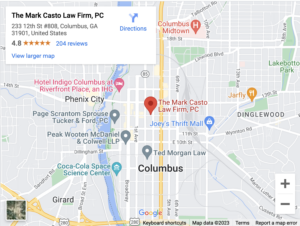
Being injured in an accident or due to another party’s intentional actions can change your life. Many people heal completely after an accident. However, if your injuries result in long-term impairments, you may experience a significant change in your quality of life.
What Is Reduced Quality of Life in a Georgia Personal Injury Case?

Defining “quality of life” can be challenging because everyone prioritizes different areas of their lives. However, quality of life generally refers to overall well-being. It includes the state of a person’s mental and physical health. It also encompasses a person’s satisfaction with their lifestyle.
When examining a person’s quality of life, we consider several factors, including:
- Feeling secure and safe
- Physical and mental health
- The ability to work to earn an income
- Social reputation and status
- Where a person lives
- Career opportunities and job choices
- The ability to perform activities of daily living, including bathing, feeding, dressing, and grooming yourself without assistance
- Being able to bear and care for children
- Skills and education
- Ability to form close relationships
Quality of life is subjective. It depends on a person’s circumstances and their individual beliefs and preferences. Therefore, an injury can have different impacts on one’s quality of life depending on the person.
Calculating the Value of Quality of Life Damages in a Georgia Personal Injury Claim
Putting a price tag on diminished quality of life is complex. However, the only way to compensate an injured party for this non-economic damage is to place a value on the loss. The multiplier method is a common way of valuing non-economic damages, including diminished quality of life.
Factors Used to Evaluate Quality of Life
We begin by determining the severity of harm caused by the injuries. In other words, how severely did the injuries impact the victim’s life? Analyzing various factors can help determine how severely your injuries impact your quality of life.
Examples of factors used to evaluate quality of life damages include:
- The type of injuries and impairments you sustained
- The medical treatments required to treat your injuries
- The need for ongoing medical treatments
- Your overall health and age at the time of the injury
- Your appearance before and after the accident (i.e., scarring and disfigurement)
- How your injuries impact your relationships with other people
- The prognosis for your condition
- Whether you can conceive, bear, and take care of children
- The ability to perform the hobbies, activities, and tasks that you did before your injuries
- Whether you can perform a gainful activity to earn income to support yourself
The more an injury adversely impacts your life, the greater the value of your diminished quality of life claim. Proving this can be challenging. In addition to your testimony, we often obtain statements from family, friends, and others who know firsthand how your injuries have impacted your life.
Testimony and opinions from medical specialists and other experts establish the severity of your impairments and disabilities. This evidence is essential in evaluating how much your claim is worth.
Applying the Multiplier Method to Value Diminished Quality of Life
The multiplier method assigns a value to your quality of life damages and other non-economic losses. The multiplier is a number between 1.5 and five. As the severity of your damages increases, the value of the multiplier increases.
For example, the multiplier in a case involving complete paralysis might be five because the level of damage is extreme. However, the multiplier in a case involving a broken arm that heals completely without any impairments could be 1.5 to 2.5, depending on the specific circumstances.
The multiplier is multiplied by your economic damages, which represent your financial losses and expenses. Examples of economic damages include lost wages, medical bills, and out-of-pocket costs.
Does Shared Fault Apply to Diminished Quality of Life Damages in Georgia?
Georgia uses a modified comparative negligence standard for personal injury claims. Comparative negligence applies to all damages in a case, including diminished quality of life.
If a victim is 50% or more at fault for causing their injuries, they cannot recover money for their damages. Therefore, if you were 60% to blame for causing a car accident that resulted in your injuries, you would be barred from recovering compensation from the other driver.
However, if your fault is less than 50%, you can receive a portion of your damages. The judge would reduce your compensation by your percentage of fault.
Insurance companies undervalue quality of life and non-economic damages. Comparative fault is one tactic companies use to avoid paying a fair amount for personal injury claims.
Contact a Columbus Personal Injury Attorney For Help Calculating Your Quality of Life Damages
You could be entitled to compensation for the harm and losses you suffered because of another person’s wrongful or negligent acts, Mark Casto Personal Injury Law Firm can help you navigate your legal matters. Contact us for a free consultation with a Columbus personal injury lawyer for more information about how we can help you with your claim, call us today at (706) 940-4030.

